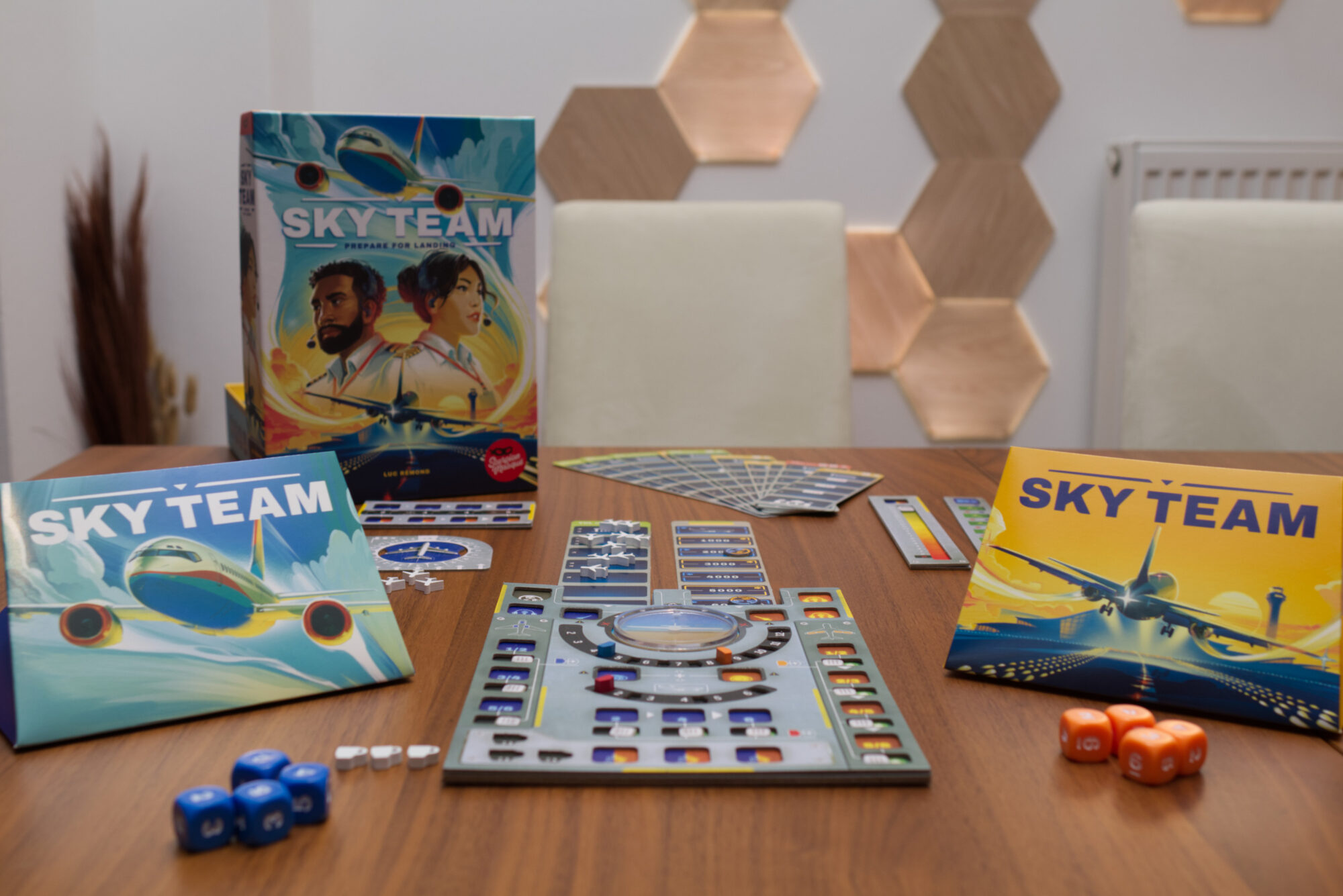Standing in front of the soon to be opened gates of the world’s largest board game convention, I was ready. A large crowd had been building up, waiting. But I had arrived early, so I was towards the front and would be inside the halls among the very first. I had read the pre-fair coverage of new games, checked hall plans, plotted routes for making purchases, and even figured out what the best entrance would be. All I had to do was decide on which game I should rush towards to first and I would have a good chance to actually get a copy.
While there are tons and tons of games to play and purchase at SPIEL Essen, each year a couple of them are only available in small numbers as publishers have to airfreight them in last minute (and above cost) to get a piece of the marketing buzz. Those games are often sold out within the first hour or two, hence coming prepared can pay off. In addition, lines are forming quickly, so waiting to get one game can rob one of the opportunity to get another. Granted, most of those games come to retail a month or two later and often even at a lower price, but still there is something exhilarating to be able to get it earlier. So what game to pick up first?
All of this might sound crazy to those that have never been there, but part of the fun of going to Essen is this rush for soon-to-be-sold-out games in the early hours of the fair. If that whole description conveys images of crowds rushing into a Target on Black Friday, you’re not too far off. There’s just way less running and people are more reserved, we’re Germans after all.
For me, the very first purchase of SPIEL Essen 2023 turned out to be Sky Team by Luc Rémond, published by Le Scorpion Masqué. This was in part intentional, but also because the booth was simply closest to the entrance. I had heard good things about Sky Team. However, if in advance you would have told me a two-player-only, cooperative dice game about landing an air plane would become my favourite purchase of the whole fair, I would have probably laughed at you.
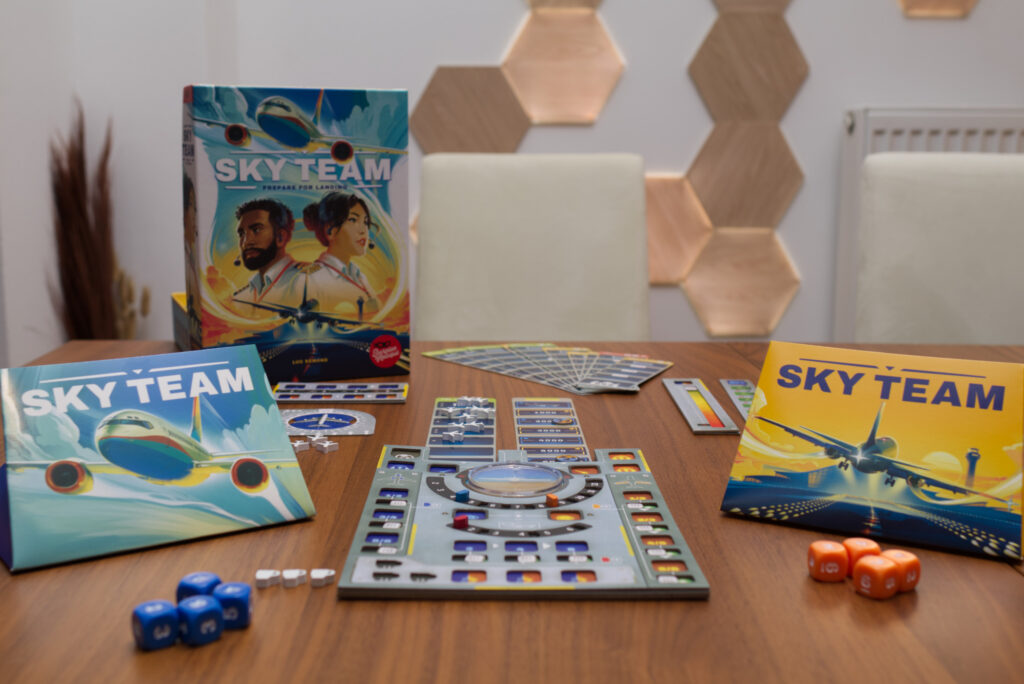
Setup
Right from the get go, Sky Team does a number of things right. For its low price of 30€, players get a reasonably-sized box (I might have played too many Kickstarters lately), a gorgeous cover, and surprisingly much content inside the box. The centre piece of the game is the shared dual-layer (self-stickered) player board that symbolises various aspects of an airplane, things like flaps, breaks, engines, and so on. A transparent plastic disc is slotted into the artificial horizon to represent the orientation of the plane, a few tiny wooden indicators and cardboard toggle switches are inserted into various other slots, and a strip showing the current height of the plane is slotted in from the top. Finally, players pick one of multiple scenarios in the game and slide in the matching strip into the second slot at the top. This one not only represents the length of the approach but also will contain little wooden planes to indicate traffic or directions the plane has to turn towards. Depending on the chosen scenario, players might also need to add further components like a fuel gauge or a wind speed indicator. But that’s pretty much it. We’re ready to take off … or in this case land.
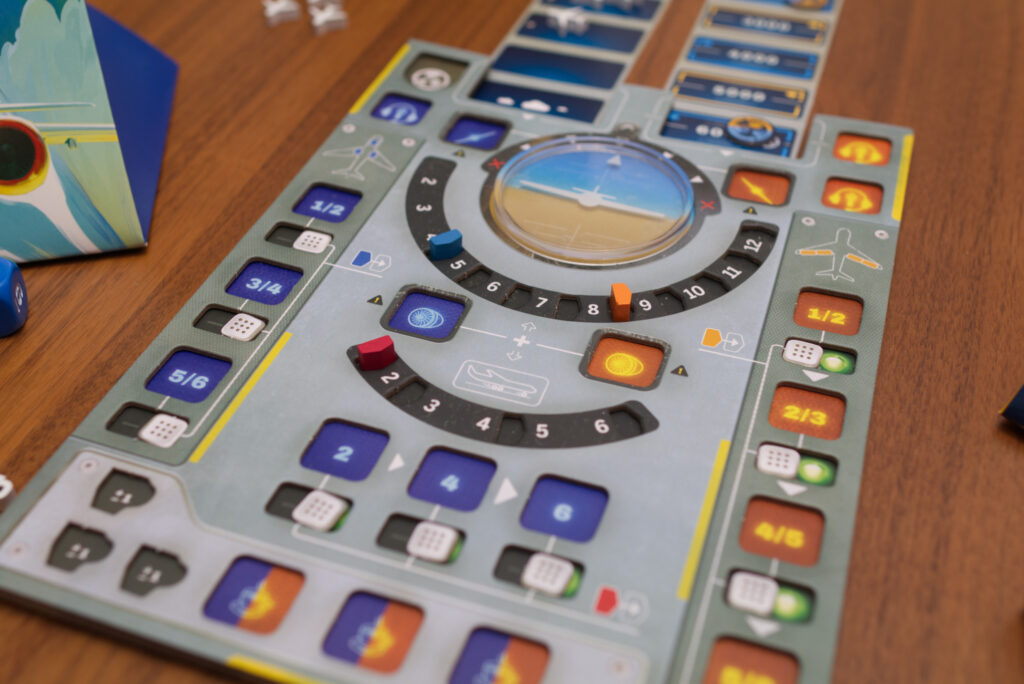
The Turn
Sky Team is a limited communication game that runs over a fixed number of turns as the plane descends. At the start of each round, both pilots can communicate and strategise on the things that need to be done. Should they accelerate or slow down? Rotate to the left or stay level? Ask the tower to clear traffic or … get coffee?!? Yes, you read correctly. This game really lays in on its theme and includes a multitude of aspects of commanding a plane, among which apparently is also the important task of getting and drinking coffee. But more on this later.
Once both players have agreed on their plan, they each throw their four dice behind their personal screens and are from now on – for the remainder of the turn – no longer allowed to talk. An arrow on the air height strip indicates which player has to go first in placing one of their dice onto the board. A number of slots require placing exact numbers or need dice to be placed in a certain order, others like the engine can take any number. Most of them though are colour coded and thus associated with one player or the other. The blue pilot has to take care of the landing gear and breaks while the orange player deploys the flaps and communicates with the tower to clear the way (thought the blue player can also do the latter in a limited fashion). Where both players interact directly is in the plane’s orientation and speed. For the former, the difference of the blue and orange die pulls the plane in one direction or the other, for the latter the sum in combination with the air speed indicators (which are influenced by the flaps and landing gear) affect how many steps the plane will take towards the airport that round. No matter if the plane will do zero, one, or two steps forward, it will always drop one step in air height.
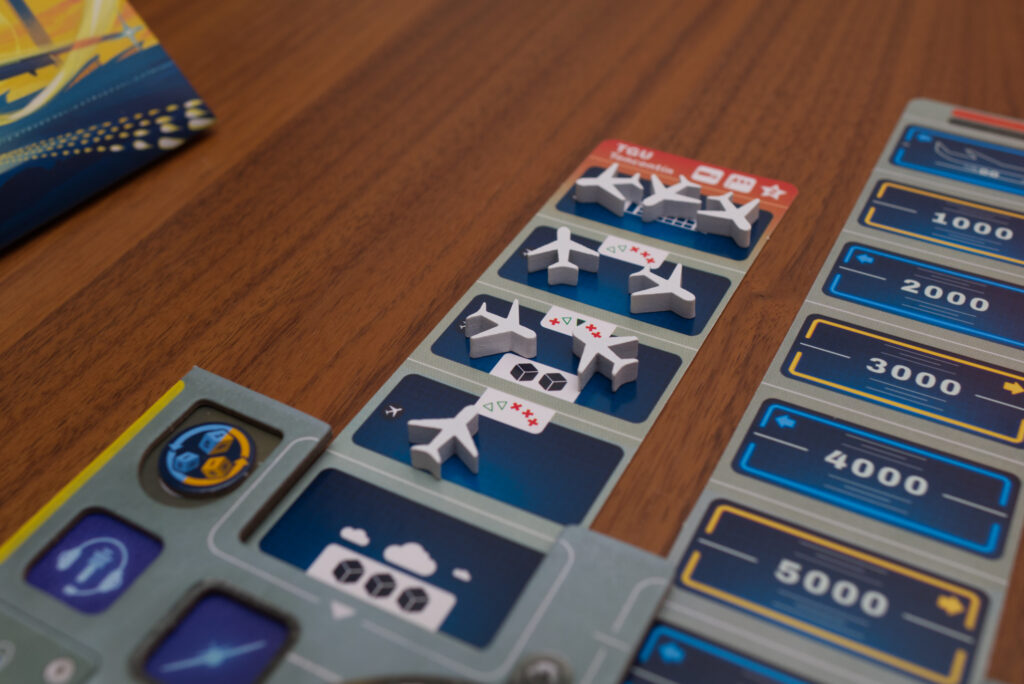
Going into details on the various actions would be a bit much here, so it is best summed up as follows: both players need to synchronise in keeping the plane on course and not make it go too fast or too slow while also managing their individual responsibilities of the plane. The central challenge of Sky Team is to both make the most out of the values you rolled yourself (so you don’t run out of time by wasting actions) but also figure out which value to place where so they complement what your co-player might have rolled (which you can’t see until they placed the die). Let’s say there is traffic right in front of the plane and you rolled a one you could place on a slot to make it go away. Brilliant, one less problem. You could do that and not instead start deploying the flaps, but then perhaps this was the only sensible action your co-pilot could have done with their one they also rolled. Or they needed you to place a small value on the engine because they only have high values which would otherwise make the plane go too fast. Or that was the only small number you will roll for the next couple of turns and you need one to kick off the sequence of deploying the flaps. Or …
Seeing only the values you have rolled, you need to anticipate what your co-player might or might not have rolled and time carefully in what order and where you want to use your dice. There are two things that make life easier for the players: depending on the difficulty level, they may receive one or two re-roll tokens they can spent at an opportune time to re-roll their dice. Also, they can spend a die to make coffee and place a small, very cute coffee token onto the board. At any later point, either of the players can use a coffee token to increase or decrease one of their dice by one. This doesn’t sound like much but can have huge impacts. The downside is that every die spent on making coffee is basically a wasted action as the die is not available for any of the other actions that need to be completed before game’s end.
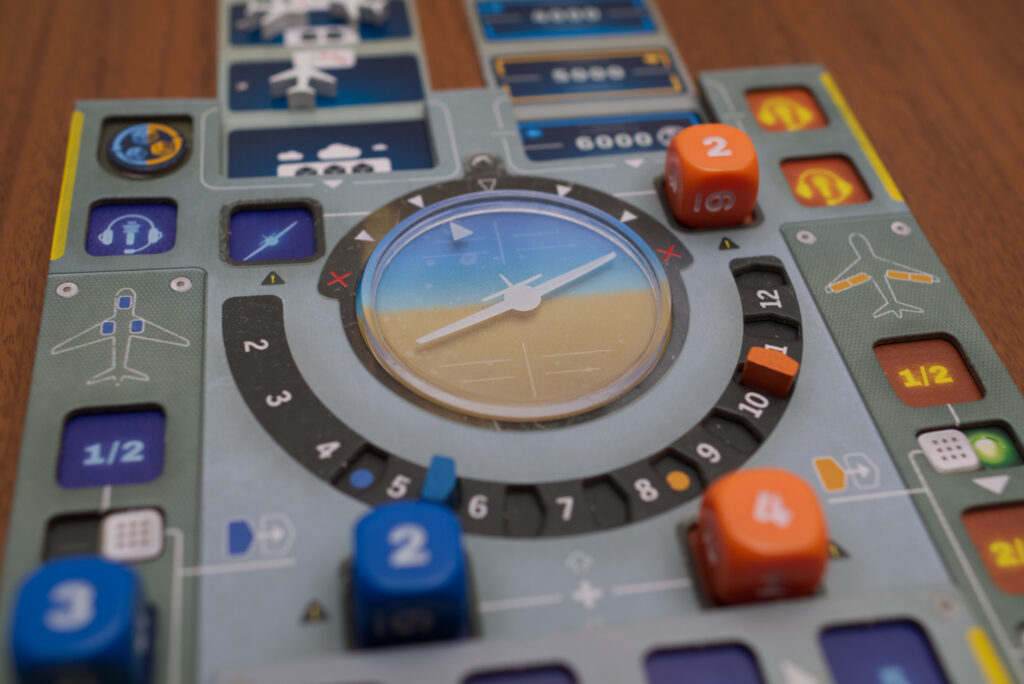
Game End
Once the air height strip is at zero, the approach strip needs to show the last step (the airport), the plane needs to be level, the landing gear and flaps need to be fully deployed, and the sum of the engine dice has to be below the breaking power of the plane. If any of these criteria are not fulfilled, you’ve crashed and can only reset the game to try again. But often the plane won’t even make it to the airport. Ran into traffic? Crash. Overshot the runway? Crash. Ran out of fuel? Crash. Turned too far too quickly? Crash. And so forth, and so on.
While it only takes a couple of plays to keep the plane going and avoid traffic, having everything ready for when the plane hits the ground is another story. I’ve had it numerous times that I carefully approached the airport, kept the plane level, the engine speed at the right amount, but hit the airport with the flaps not fully deployed for example. There are a lot of things to do during the approach and having only four dice per player can quickly get you into trouble.
Scenarios and Modules
Once players have successfully managed their first landing, they can either simply reset and redo it, or progress to one of the 20 other scenarios contained in the box. Compared to the initial starting scenario, a number of new factors are added: the approach strip might be shorter or longer, require you to put the plane into certain orientations at specific points of the approach, cause traffic to randomly pop up, and much more. Through various cardboard attachments, new aspects like fuel running low or the runway being covered with ice are introduced, all of which require you to spend yet more of the valuable, limited amount of die-actions you have.
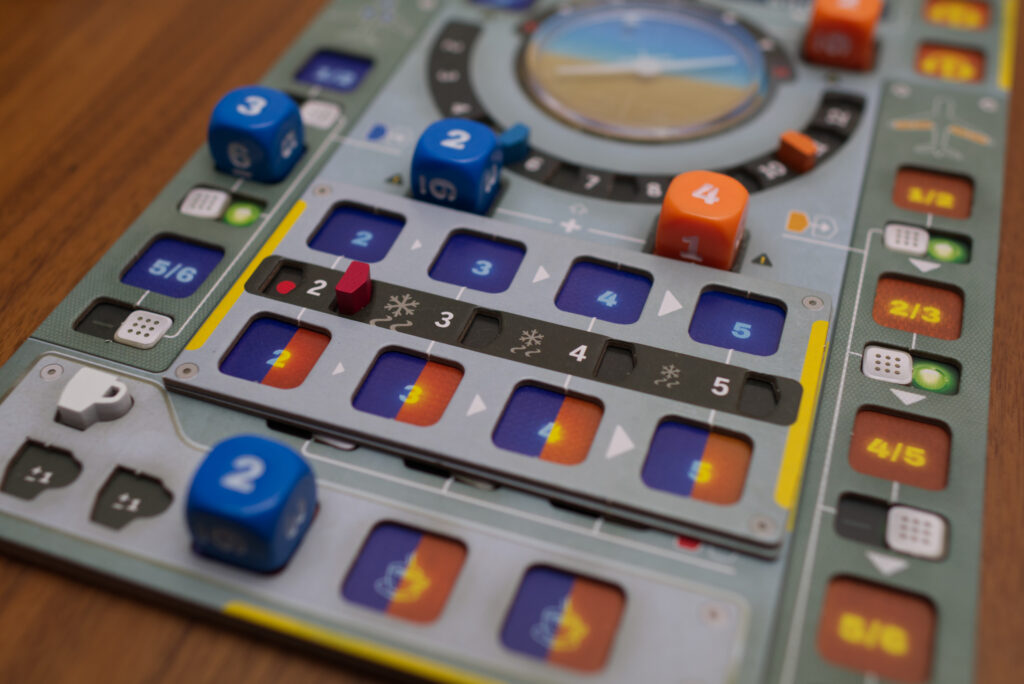
To compensate this, most scenarios provide the players with 1-2 special abilities such as getting a free coffee whenever both players use the same die value for the orientation or being allowed to trade dice. This creates an interesting mix because even if you re-play the same airport multiple times, how the dice will fall and which special abilities you draw will change. Though it has to be said that there are only a handful of such cards in the box and variety in that single aspect is not that big.
Speaking of scenarios, there currently exist two promo airports. I’ve got Düsseldorf (the promo for Essen) which is a lovely thematic tie-in because Düsseldorf is the closest larger airport to the city of Essen where the convention was held. But in a very nice move that other publisher could learn from, the team of Sky Team provides the promos as print-and-play on their website. So even if you miss out on a promo, you can still play it.
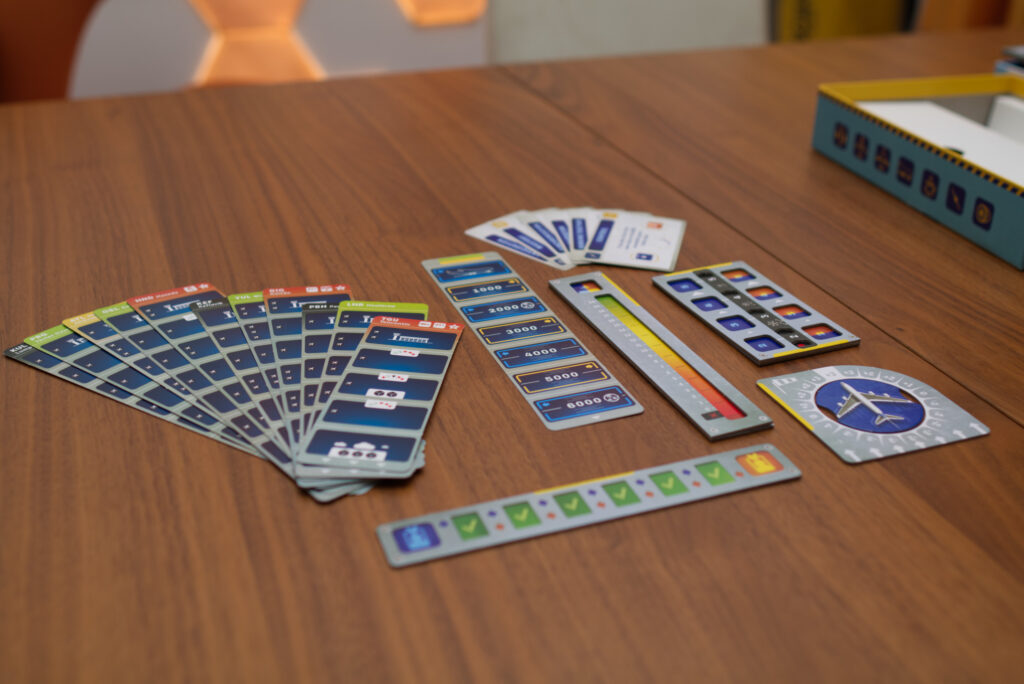
Solo Mode
One of the biggest surprises and/or shortcomings for me is that Sky Team doesn’t come with an official solo mode. A BGG user has proposed to simply roll and place all dice of the starting player first and then roll and place all dice of the other player. This works fairly well and provides a lovely puzzle, though the shared anxiety and limited-communication signalling with dice is of course missing.
Conclusion
Sky Team has a lot going for it, starting of course with the lovely theme and production. The box cover is great, the airports feel thematic and are inspired by the approaches to their real world equivalents, the wooden airplane traffic tokens are super cute, the dual layer player board makes slotting in your dice or flipping a toggle switch a satisfying experience. Everything about this games just makes me smile. I wished the toggle switches would have been wood instead of cardboard, but otherwise there is little to wish for here.
Quite the opposite in fact: I was surprised how little plastic waste there is in this game. The box is held together by only two stickers instead of plastic wrap and the smaller components come in a paper envelope instead of plastic bags. This is quite a stark contrast to for example the Standard edition (=no minis) of Voidfall, which produced such a huge pile of waste during unpacking that I seriously got a guilty conscience. The reduction of plastic waste in board games seems to be a recent trend (e.g. Friedemann Friese’s new game Freaky Frogs from Outaspace also used paper to wrap the contained card deck instead of plastic), but it is one I really would like to see extended to more games!
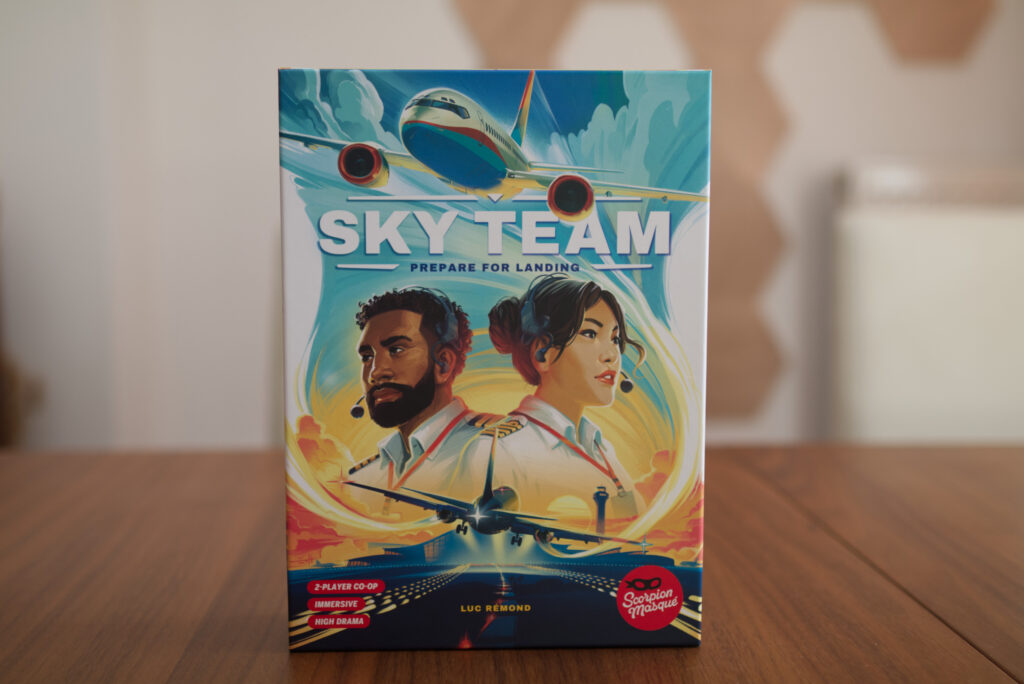
Thematically, this games hits all the right buttons. From its manual to its airports, from the little green lights that appear when you slide a toggle switch, to the artificial horizon, it just feels like someone has put a lot of love in this game. The fact that the breaks need to be build up before the plane even hits the ground feels somewhat off to me, but hey, nobody said this is supposed to be a simulation. The fuel gauge and wind speed module are cool while the intern is a bit too artificial/mechanically for my taste. But overall it can be best described by the fact that I multiple times had started a new scenario and was halfway into the approach before I realised I had overlooked the symbols that told me which other module or special ability I should add. It’s just plain fun to slot in the new airport and go for it.
Gameplay-wise, Sky Team works great. There is of course randomness in the die values you role and when you’re just not hitting the right numbers, that can be a bit frustrating. However, Sky Team’s difficulty in the starting scenario has just the right balance between being achievable even for new players but also feeling tense. The other scenarios progressively introduce more and more modules and ratchet up the difficulty nicely, ending in airports which should provide an interesting challenge for a long time. Of course, Sky Team is a rather lightweight, 10-20min game. So for me it will mostly function as a nice filler or chill sofa game, not something I will play more than 2-3 scenarios in a sitting. But for what it is and for its very reasonable price, it packs a lot of bang for the buck.
To sum it up: Sky Team both as a game and a production does so much right, it’s remarkable. There are few games which I can blindly recommend to anyone, but I can do so here. Don’t expect the biggest, deepest game in the world. However, I struggle to name another 30€-game that provides such a pleasant, rounded gaming experience. If you have someone to play 2p-only games with, get it!
